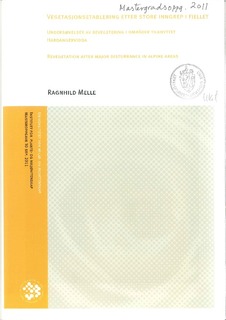| dc.description.abstract | Undersøkelsen fant at masseuttakene i stor grad var revegetert etter 30 - 45 år, men at vegetasjonen i masseuttakene fortsatt var ulik den uberørte vegetasjonen rundt. Dette skydtes at massuttakene var i et tidligere suksesjonstadie enn vegetasjonen rundt. Revegetation and succession after human intervention in alpine environments, was studied by comparing the vegetation of four older quarries with the unspoiled nature surrounding it. The quarries where found in subalpine and alpine areas in Telemark and Hordaland county in southern Norway. They were established with the purpose of hydropower development and decommissioned around 30 to 45 years ago.
The studies showed that revegetation was well established in all four quarries with the exception of dry areas with low nutrient levels. However, even though the vegetation in the quarry areas where well established, it differentiated substantially from the surrounding areas. This occurred because the vegetation in the quarries where still in the pioneer and developing phases, while the vegetation in the surrounding undisturbed areas where in the climax phase.
The undisturbed areas around the subalpine quarries where dominated by mountain birch forest, while the average height of the mountain birch in the quarries where no more than 1, 2 meters. This lack of shade compared to the undisturbed areas around created a larger degree of shrubbery in the quarries.
An unusual amount of graminoids where found in the alpine quarries, due largely to attempts at seeding non site-specific grass as a part of the restoration process conducted 30 years ago. High amounts of the fast growing common bent-grass (Agrostis capillaris) led to large amounts of slowly degrading litter, which in some areas accumulated in a layer just above the ground.
Humidity and nutrients in the ground proved to be an important factor in the revegetation process and the successional development. The vegetation cover was denser, and the succession rate was higher in areas with medium soil humidity and medium nutrient levels, than in areas with dry soil and low nutrient levels. Slope degree and exposition where also registered, but showed less importance.
The revegetation was successful in all four quarries, assuming the goal was merely a vegetation cover. The subalpine quarries also showed positive results of the restoration as a whole, meaning the areas will probably develop into a natural part of the mountain birch forest given time. The quarries in the alpine areas however proved somewhat less successful, due to the unnaturally high density of seeded common bent-grass, which will probably dominate these areas for the foreseeable future. | no_NO |
